9
Entrants
Initial eligibility criteria were based on a search for a level of maturity which was likely to enable a cadet to be sufficiently advanced to handle and come out of a short intense course ready to command a platoon. The desire to attract 18 year old national servicemen kept the lower age on application to that, which meant eighteen and a half on entry; the upper age of below 23 on entry was set to allow a graduate the chance of a long term career, though the formula for that precise age is unclear, particularly in view of the older men accepted through officer qualifying courses. However there was an underlying feeling to compare the career profile to that of RMC graduates who were commissioned as lieutenants from 20 to 23. Education was accepted at a minimum of intermediate level, as it was intended to take on those not eligible for RMC, though the potential to pass at leaving was considered as there was no intention of retaining officers in the Staff Corps who could not attain that level. A high medical standard and minimum height of 5ft 4in were set, together with an officer intelligence rating which would enable a student to cope with the high input of instruction and end up as a thinking officer. The input was a mix of Regular and CMF NCOs, national servicemen, and civilians, many with some school cadet experience. The first seven courses showed a remarkable similarity in composition: the average age was about 20, about half had a post-intermediate education, and officer intelligence rating averaged just under 7. A quarter came from ARA, 40 percent from national service and CMF backgrounds with the rest civilian entries (1).
These entry criteria remained stable until changes to entry categories required exceptions to be made. Starting in the first 1953 course it was decided that RMC cadets who had not made the academic standards there but were still considered suitable officer material should be offered a place at Portsea; with some cadets entering the former at 16, the minimum age for OCS would obviously have to be waived to give effect to this decision. Similarly military survey cadetship entrants were also subsequently accepted at seventeen and a half to allow younger university students in. Then in the opposite direction, when a special entry category was created for those having degree or diploma studies, the upper age was increased to 25, allowing for the time consumed at tertiary institutions, and graduation rank was set at lieutenant for completed courses or a lesser period as second lieutenant for incomplete ones. The age was subsequently raised to 27 to accommodate additional students from serving soldiers, but after an extended period of attempting to reconcile an age spread encompassing school Ieavers through to hard-bitten warriors, that was reverted to 25 (2).
Educational entry standards remained at a minimum of intermediate or Army Certificate of Education, until raised to Leaving in 1968, when the internal subjects of english expression, applied logic and appreciations, military arts, and government were accredited as the Services General Certificate of Education for service entrants. This met the criterion operative from the beginning that leaving level was required for promotion to lieutenant and hence becoming a career officer, and diluted concern on educational levels; the actual standards on entry rose of their own accord in line with those in the general community. The original fairly even split between intermediate and leaving or near-leaving students, after sagging in the 1960s, gradually rose to 71 percent at leaving or better in 1975, at which stage it was deemed safe to raise the minimum education requirements to completion of final year secondary education for civilian entrants and to SGCE for service entrants (3).
Study – 1959
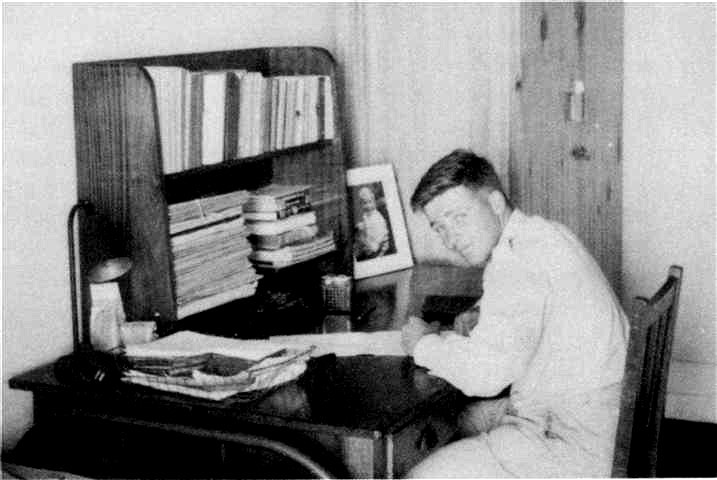
Selection emphasised leadership potential, fitness and mental ability to cope with the course. The approach of students was another matter when it came to the academic side of the course, many having selected OCS for just the reason that they did not want to continue studies, looking to a life of doing and action.
The hard reality was that there was much to learn on the administrative side as well as general education, communication and the bugbear of passing leaving-level subjects for advancement from second lieutenant to lieutenant. This latter then opened the way to endless study for promotion to higher ranks, specialist training, staff colleges and technical qualifications.
B.L. Hayhow at his desk in his room comes to grips with this. Dress of the day was required, but at normal night periods this meant blues, hardly conducive to effective study.
Photo: D.J. McLachlan
While initial applicants were recognised according to their service or non-service background for the purposes of analysis, there was but one category of entrant and graduate. All entered under the same conditions other than non-reduction allowance for service entrants, and all graduated as second lieutenants with another three and a half years to serve before promotion to lieutenant, the one year course reducing this to three years, all based on the total time in training and service at OCS equating to the RMC four years. Then provision was progressively made for special entry conditions for those with tertiary level studies and, when the OTU demise closed that avenue, survey and flying scholarships. Tertiary graduates were commissioned as lieutenants, two-year undergraduates as second lieutenants with six months to promotion and one-year undergraduates had one year before promotion. Also, in recognition of their qualifications, higher rates of pay above the standard corporal rate for normal entry cadets were allowed.
Change continued. When the prospect of a shift to the ADFA-RMC system was resurrected in the mid 1970s preliminary steps were taken for a steady progression to that goal: the time before promotion to lieutenant for normal entry graduates was reduced to two years; WRAAC OCS entry standards were harmonised with those of OCS in 1978; and as a result of the 1979 Regular Officer Development Committee proposal that officer training be set at 18 months, with ADFA graduates excused the first six months and all graduates to be lieutenants, the WRAAC course was doubled to a year then absorbed into OCS at the end of 1984; the normal entrants to this last graduating course were consequently required to remain as second lieutenants for only six months in recognition of the transition from a four year to one and a half year production cycle to the rank of lieutenant (4).
The source and nature of entrants was the subject of ongoing discussion for many reasons. The initial plan leant heavily on serving regular and CMF soldiers with a parallel emphasis on national servicemen, so much so that the Director of Military Training found it necessary to advise the Adjutant General to amend the instruction on establishment of OCS to include provision for civilian applicants. Civilian applicants came from ‘a large field of young men in the 19-23 age group who will satisfy all the other conditions of eligibility’ other than a service background (5), and indeed such entrants to the school always made up a substantial proportion which, with some spectacular ups and downs from 15 to 77 percent, averaged at about half over the life of the School. Average age was remarkably steady at around the 20 mark with a lowest of 19.58 and a highest of 22.17.
Selection
From its inception applicants for OCS were assessed by a selection board consisting of the commandant, one or two senior officers appointed from the army at large, assisted by a psychologist. This board visited each of the state capitals, and when required Papua New Guinea before independence, to carry out interviews and tests, its duration depending on the numbers of candidates offering. In the leaner years where there might be 60 or so, two weeks sufficed; but with later years of 200 the task became a drawn out process lasting six weeks or more each half year which, with other visits, kept the commandant out of circulation for about a third of the working year (6).
Teamwork – Confidence course 1953
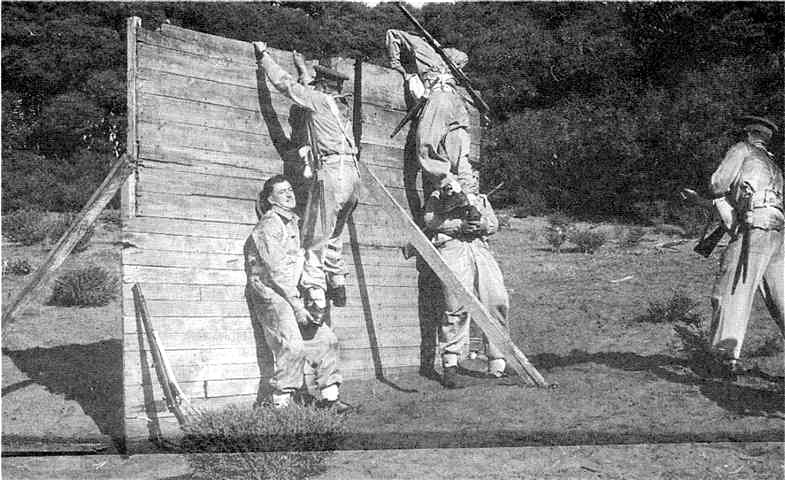
Similar to some of the pre-entry aptitude tests used for later courses, the confidence course was both a physical test and a test of problem solving and cooperation.
From the drill square with starched khaki uniforms, blancoed and polished webbing and dress caps, they were launched straight into field training without the opportunity to change into field dress, and facing the nightly task of refurbishing it all afterwards.
Well might the early courses muse on how hard it was in their day, not only for the sake of their spoiled clothing but also on having built the course themselves before having the privilege of using it.
Photo: G.L. Precians
Selection was based on a range of factors: age, physical fitness, education, officer intelligence rating and leadership potential; age and educational standards have been discussed above. Educational achievements and officer intelligence rating were taken as a guide to the ability of an applicant to cope with the intensity of instruction on the course; leadership potential was an assessment of capacity to mature and so be suitable for commissioning at the end of the course. Basic aptitude was assessed against the officer intelligence rating, a percentile scale of 1 to 10 which represented the spread of serving officers’ scores in psychological aptitude tests. The scale was established when the officer corps had a high proportion of carryover officers from World War 2, and excluding the minority of RMC graduates, 25 percent had an educational level of below intermediate and an additional 65 percent leaving and below. In consequence applicants below an OIR of 4 were not considered and those with 4 were found by experience to have great difficulty passing the course and were not accepted unless they possessed some special ability needed by the army. The OIR of entrants started at a high average of 7, then slipping to the 6 to 7 level, which still ensured the capacity to pass the course; and to the army it gave graduates with the potential to fill a wide range of staff as well as regimental appointments, and the capacity for promotion of the best to the highest levels.
Physical Training in the Gym
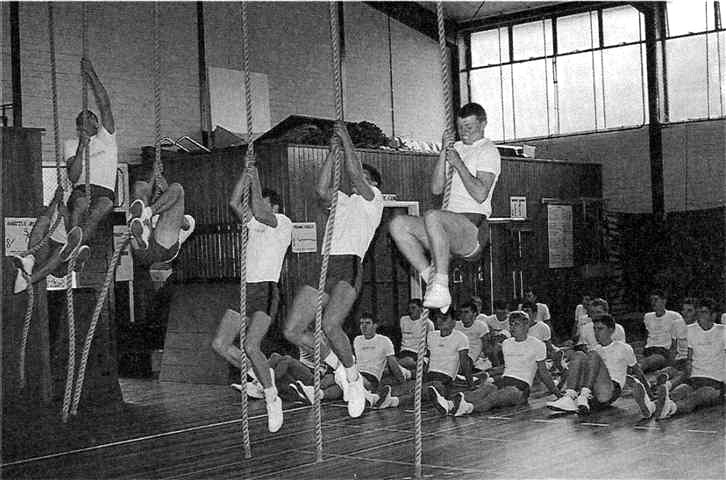
After an over-extended period using whatever temporary facilities might be available or holding classes in the open, the 1965 construction of a purpose-built gymnasium provided the School with a properly equipped venue for an important part of students’ physical conditioning and remedial training.
While there was an adequate staffing level of physical training instructors, their experience level fell away in parallel with the expansion of OCS and the army at large, causing some inter relationship difficulties with the cadets, however experienced senior PTIs were usually able to cover these problems.
Behind the gym lay the scramble track up the hill, used for both class outings and as extras for those not putting in enough effort for the taste of the instructors.
RMC Archives
Physical fitness was an essential asset for a young man or woman about to undergo an arduous course and a career in which physical and mental fitness and stamina were background requirements for both active and sedentary employments. There was also the need to screen out those with predispositions and injuries which might not only inhibit their course performance and later service, but also become a source for later compensation if undetected on enlistment or aggravated in service. Applicants tended to be from the active category, so the rejection rate on physical grounds did not approach the 50 percent common in normal recruitment for the regular army and the national service ballot winners.
Swimming training – 1971
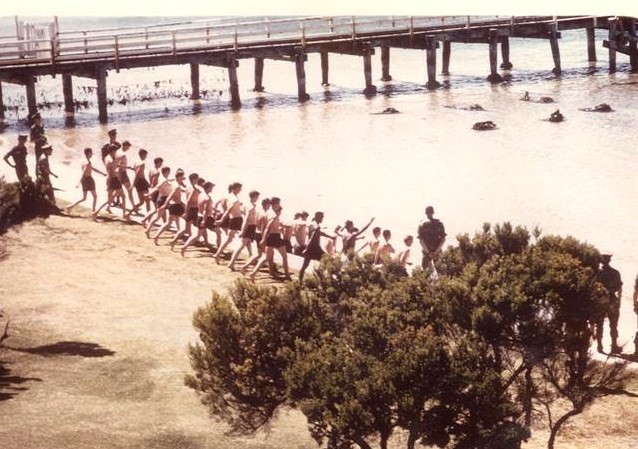
The course probed all areas of physical endeavour, always looking to promote personal fitness, teach necessary individual skills, inculcate teamwork and establish the ability to organise and teach an across the board range of physical activities and skills.
Swimming was promoted as both sport and military skill. The latter included expedient flotation and ability to swim freely, meeting standard army tests, clothed and unclothed.
Basic swimming was conducted at hired pools in the area. On test days the simplest way to encourage cadets into the icy water of Port Phillip was to march them in and worry about organising the tests after the initial immersion had broken the ice as it were.
OCS Scrapbook 1971
Leadership potential was assessed by a series of aptitude and group activity tests plus interviews. These were a modified version of the British War Office Selection Board technique developed for the wartime mass production of officers, choosing mature young men to do a three month course then take command of a platoon in operations. This successful technique was continued for their postwar national service scheme, turning out three-month officers from Mons and Eton Hall OCS for service with their NATO force, but once adopted for the Australian Army it became pervasive, being used for both RMC and OCS, but its utility for longer courses was substantially untried in the absence of controlled comparison of other techniques. The written aptitude tests and psychological interviews were standard fare, able to provide a profile on some characteristics and abilities, but the associated group activity test of problem-solving gave plenty of scope for pre-test coaching and playacting for the knowing, to the disadvantage of unprepared participators. There was a world of difference between choosing men to be ready for war in three months, without any long term pretensions, and those to be chosen for a long course and a long career during which maturation, moulding and experience changed characters markedly. While commandants in earlier years considered the selection system satisfactory as the wastage rate was low (7), later rates as high as 51 percent and routinely 25 to 30 percent indicate significant failings for which selection must shoulder at least part of the responsibility.
Different commandants selected entrants on somewhat differing perceptions of what constituted the best raw material. One was renowned for rugby as a primary revealer of the right character in selection and during the course, yet the same man attempted to undertake some much overdue reform and persisted with etiquette and dancing classes. Some favoured the maturity, experience and higher graduation rates of serving soldiers, and with the age spread when service entry age was raised to 26, school-leavers had great difficulty in matching the military achievement standards of service entrants, so selection boards tended to recommend their deferment for a year in which time, as well as some gaining maturity in real life, many suitable candidates joined that world and were lost to the army. Commandant Col G.D. Burgess, who considered OCS a place for civilian school leavers, was concerned that the one third service entrants were largely the higher age group, making two distinct social groups in which development of the younger was the loser. GOC Training Command Maj Gen D.M. Butler, who as commandant had pushed for targeting university students and graduates, was able to sympathise with this view and successfully argued for reversion to a lower age ceiling (8). But whatever values commandants brought to the selection arena, all were concerned to keep up the standard of end product and keep down the loss rates. While there were many other factors in passing or failing the course, choosing the right material was the foundation of the success for which they strove.
Recruitment
To get satisfactory entrants there had first to be satisfactory applicants. Several natural sources of students for the School existed and developed. The natural talent revealed in the ranks of NCOs in the regular and citizen forces, which had provided the basis of officer production in the early stages of both world wars, remained latent and just needed the stimulus of expansion to make this an attractive option: the percentage of such entrants rose in the 1950s and 1960s army expansions. A secondary effect came with the parallel national service schemes, where young men’s interest in the army as a career was awakened and when the option was presented to them they also became a significant resource. Then from 1953 a steady trickle came from RMC cadets who could not make the grade in tertiary academic studies and opted to finish their training at OCS, a natural progression at that stage considering that part of OCS’s purpose was to pick up the leadership talent which would have difficulty with an academic course. The 1970s development of surveying and aviation scholarships after OTU closed also provided a small input, but the remainder came from the general community of young men and latterly women who, at the end of their schooling or after they had had unsatisfactory initial job experiences, looked for an active and satisfying career. While servicemen might regard attending an officer training course as a natural extension of their service career, and aviation and survey scholarship holders accept that it was part of the course they had set themselves on by deciding to fly or survey in the army, the recruiting challenge lay in persuading civilians to embrace the idea of entering a leadership career in the Australian Regular Army.
Final field training – June 1966
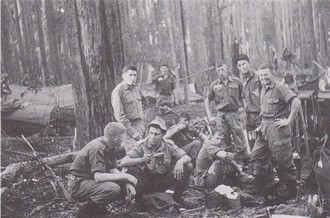
In camp at Taggerty State Forest, which became one of the regular venues in central Victoria through which field training was rotated in the 1960s.
These cadets were facing a milestone in their assessment – the juniors on their achievement of trained soldier standard, the potential graduates their ability to command and qualify for graduation.
For those who were to pass it was the opportunity to consolidate their basic knowledge in realistic exercises. For the doubtful it was a make or break event which kept them on a knife edge. All were glad when it was over, if for no other reason than it heralded the end of the course and preparations for graduation, leave or leaving.
Photo: K.W. Van Den Belt
To get the message to potential applicants was the first hurdle; another was for the message to be persuasive; and the third was to make it realistic so that those attracted by it should not be under any sugar coated illusions or false expectations, for the course was a testing ground not only for the army to determine if the student would make a useful officer, but also for the aspirant to determine if the army suited him. The army did not want unwilling candidates, and candidates did not want to be conned into a queen’s shilling for a life which quickly turned sour because of misrepresentation. A sensible approach was established where the Director of Recruiting and advertising agencies consulted the School on advertising campaigns and the content of advertising, with the aim to present a combination of an attractive course and career, while also emphasising the standards required and imposed (9). This cooperative approach did not produce the considerable numbers as do the greed-based ones of today, but the voluntary withdrawal rate was minimised. Lean recruiting periods for the army were lean recruiting periods for OCS, reflecting community interests at the time. When defence issues were active, so were the applications; and in latter years after Vietnam when the national era of over-full employment ended and easy access to professional jobs faded, the attraction to an army career remained sufficiently to sustain the entry of high quality candidates.
Recruiting advertisement – 1963
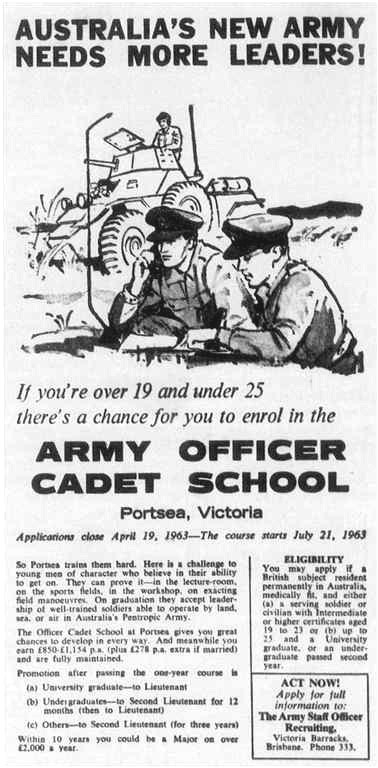
With expanded targets of 140 graduates a year, class entries needed to be at about the 100 mark for each of the two classes to allow for last minute withdrawal and wastage rates.
This was a real challenge after the slim application levels of the late 1950s and early 1960s, however a worsening situation in Vietnam and reintroduction of national service training, plus a 25 percent pay increase, combined to bring an adequate response. However even with the urgency to maximise applications, the advertisements emphasised leadership and toughness of the course as well as the rewards.
Timing was critical in allowing reasonable space for consideration, without too much time to forget or after selection to move on to alternative employment. The advertisement was published in mid-March for applications by mid-April, selection in May and entry in July.
Photo: Courtesy The Courier Mail 19 March 1963
Attempts were also made to use visits to promote OCS as a desirable career avenue in an effort to improve both numbers and quality of applicants for entry. In 1953 the headmaster of Scotch College Perth visited to assess the course, but this was not followed up systematically until, with badly sagging applications for entry in the late 1950s, a programme of encouraging school principals to visit OCS and RMC was tried. The OCS contingents, with 20 and 12 in the two terms of 1960, was superficially successful, but Perth Modem School provided the only one from outside the greater Melbourne area, so its impact on Australia-wide sales was negligible. Another approach was through school cadet units, ARA cadre staffs visiting in organised groups of 28 and 34 in 1960 and later interested individual regional school cadets were given a look at officer cadet life, but with the general age group couched above school-leavers, this also had limited utility. A more systematic national approach was developed in the early 1960s with an Army Team of Lecturers and career counsellors. A member of the former, Maj H.L. Bell, was a graduate and so well able to present a credible view of OCS and commissioned service of graduates on visits to secondary schools, but when this was replaced by defence recruiting agency career counsellors, it was found necessary to run courses to bring inexperienced army members up to speed on various establishments, so each course visited Portsea to gain a first hand knowledge to pass on (10).
Conditions of Service
OCS cadets differed from those at RMC in that, while the latter were considered to be a full time junior students and therefore provided with lodging, board and clothing with consequent pay levels to meet personal expenses only, the former were regarded as enlisted soldiers doing an in-service course of instruction, so pay and conditions were determined on the same basis as any soldier (11). Given this basis, everything flowed on logically but commandants continued to seek a special status for their officer cadets which a hard-headed public service and military bureaucracy was quite unwilling to concede. All changes in entitlements had to be approved by Department of Treasury and its delaying tactics were well honed; as an example Maj J.C. Hoare as DAQMG at RMC in the early 1950s put forward a special scale of gymnasium and sporting equipment for the college, and on being posted to the Directorate of Military Training at Army Headquarters seven years later found it still being stalled by Treasury; after retreading it as a special scale for RMC and OCS and following it up regularly, he made little progress three years later. The mills ground slow, and it was not until the transfer of delegations to Defence in the mid-1970s that the fineness of their product began to provide some of the benefits of special clothing and equipment sought by the School.
Cadets were enlisted as private soldiers in the Australian Regular Army if they were not already engaged, or were required to re-engage in advance if their residual service was insufficient. Holders of commissions in the CMF were required to resign them before entering, while NCOs relinquished their rank. They were expected to complete the course, but allowed discharge if this was not possible or they opted to withdraw. Those who left the course voluntarily or involuntarily were allowed to complete their engagements as soldiers if considered suitable; graduates were discharged on the final day of their course and commissioned the day after (12).
In the planning stage for OCS, in keeping with the concept of soldiers on a course, it was decided to strike a pay rate of that of a corporal one star, that is a trained junior NCO which might be held to be the median level of their transition from recruit to junior officer, but also allowing those soldiers holding higher rates to retain them as a non-reduction allowance. For their pay on graduation, the recruiting brochure and internal correspondence stated that a special rate of pay had been struck for second lieutenants, but the first course quickly compared that rate and found it to be precisely the same as the corporal one star rate they were already getting. In the face of a strong reaction to this too-clever piece of legerdemain a quick increase was promulgated to mitigate the potential for permanent damage (13). This incident provided an early demonstration of what graduates found during later service: no significant increases in pay were won by the efforts of the personnel branch of the army, they arose from reviews forced by the actuality or prospect of large scale defections.
Initial issues – 1959
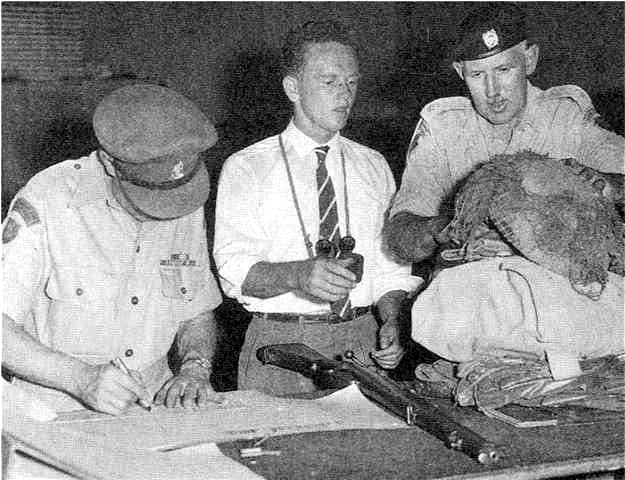
On arrival civilian entrant P.M. McDougall was provided with clothing and equipment necessary for the course, here by Quartermaster Maj W.E. Beauchamp. The service entrants had already received the normal scale of issue which they had to maintain with their uniform maintenance allowance; they received in addition the OCS recreation, physical training and sporting dress plus officer pattern cap, weapon and equipment. Civilian entrants were reclothed completely, from underclothes and boot brushes to greatcoat and dress blues.
After receipt, these had to be taken back to rooms, folded or hung in precise detail, and left that way with as little disturbance as possible, the lucky ones having extra sets to avoid disturbing the basic piles.
Photo: R.L. Bricknell
Clothing scales were long a contentious and tendentious matter. Serving soldiers already had their standard recruit issue of clothing and necessaries, and civilian entrants were given this initial scale: both were given additional pool clothing in the form of protective dress, blues and from 1961 white mess jackets, all returned on leaving to be reissued to later cadets. The only significant items above basic and training clothing provided was a reefer jacket, slacks and tie as recreational uniform, a tracksuit, PT and football uniform and, in sole recognition of their officer candidate status, an officer pattern cap and white gorget patches. In the mid-seventies after the dead hand of Treasury had made way for decisions within Defence and defence budget limitations, OCS was belatedly permitted to follow RMC with officer pattern blues and white summer ceremonial jackets, with tailored mess jackets instead of pool ones. In all the discussions about conditions, OCS argued for parity with RMC other than for pay their own being considerably higher, while Canberra thought in terms of the basic proposition of soldiers on a course, in the same sense not just as corps schools but also such a prestigious establishment as the Staff College. This feeling persisted even though OCS had long become an academy rather than another army school, and through much negotiation there was a progression to a reasonable compromise (14).
Cadets in battle order – 1953
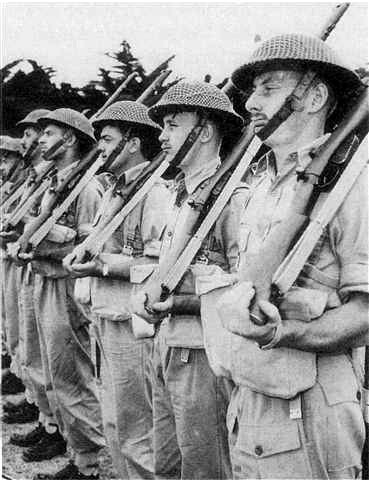
Just as the army between the two wars existed on equipment from World War 1, so in the fifteen years after World War 2 it was equipped from that latter war’s carryover.
Officer Cadets P.L. BooI, N.H. Harden, J. Glynn, V.C.Y. Smith, N.W. Sharpe, J.L. Vickers and R.B.McN. Donaldson are in the battle order worn in the Egyptian Western Desert in 1940, with khaki drill clothes, the 1937 pattern webbing and gaiters, bolt action short magazine Lee Enfield rifles unchanged for half a century, 1907 pattern bayonets and the steel helmets of two world wars.
Even when jungle green uniforms, self loading rifles and the US sourced web equipment, helmets and support weapons began to become available from the late 1950s, OCS was not on any priority list, waiting several years to receive them.
It waited a decade longer for general purpose boots and field jackets to replace the ankle boots, flimsy pullovers and clumsy greatcoats.
OCS Scrapbook 1953
Discipline was a strong factor, on the basis of self discipline as a precursor to disciplining others. The same philosophy as applied on other issues was intended: regular soldiers under standard military law as opposed to RMC with its special regulations under the Defence Act; the single let-out was in authorisation of the commandant to award local rank for application within the cadet body, though the basis for this would not have withstood any modern test of law. In reality illegal punishments were handed out under the guise of a training system or additional training, but with their coarse punitive nature, this was quite transparent. Yet it held together, those who could not stomach it leaving, those who could and wanted to graduate accepted it, until (ex) officer cadet Miller in 1984 submitted a redress of wrongs which brought a Chief of Personnel-Army direction to adhere strictly to Australian Military Regulations; this, in the words of commandant Col P. Davies ‘effectively removes the means essential for the administration of discipline within the Company of Officer Cadets at OCS’. His impassioned call for retention of a uniform ‘training system’ following the authorised RMC code, followed as a matter of course but not law by OCS, OTU and WRAAC OCS, pointed out that the 15 percent of overseas students were not bound by AMR and in canvassing alternatives, fell back on the RMC model. This had been well enough until tested legally, and with the imminent amalgamation of the two colleges and the upcoming uniform disciplinary code for the three services, it was no time to be seeking new legal cover for Portsea. Davies’ claim that conversion to legal punishments and retraining programmes would be tainted with overtones of bastardry might be viewed by some students as the end of an existing system of bastardry which had recently awarded 418 punishments to 160 students in four months. As the commandant said, the School had operated effectively for thirty two years on the ‘training system’, but then the army had operated effectively for seventy-eight years on the legal one (15).
Overseas Students
Entry to Duntroon was for long a sacred cow available only to Australian and New Zealand cadets until a trickle of overseas students began to enter there from 1967. There had been no earlier call from other Commonwealth sources, the other Dominions having their own officer training academies, the colonies and protectorates being the responsibility of the United Kingdom. By the time that the latter were gaining independence, establishing their own armies and looking elsewhere for sophisticated officer training, OCS had opened and was able to provide vacancies not only for them but also for other regional countries under various cooperation and aid programmes, and the fledgling national army-to-be of Australia’s own colony Papua New Guinea. In addition it also made sense for the RAAF to train the few numbers of ground defence officers at Portsea rather than try to set up their own courses (16). Even when the RMC door was opened, OCS continued to take the main stream of overseas students as the most economical and suitable institution.
The first overtures were in February 1950 from the New Zealand Army, which was also feeling the pinch of a shortage of regimental officers which their small quota from RMC could not cope with. Army Headquarters advised that there were currently no Regular officer first appointment courses but anticipated they would be held in 1951, in the interim offering junior officer courses at the School of Infantry and School of Tactics and Administration. New Zealand decided to set up its own officer qualifying courses and it was not until after the successful extension of the OCS course to a year in 1955 that this avenue of training became attractive to them. The first of what became a regular stream of potential career officers entered OCS in January 1957, and after this flow became entrenched there arose a certain preoccupation by New Zealand Army Headquarters with the failure rate of their cadets, though with over 80 percent graduating compared with 70 percent for Australians, the reason is hard to find other than as an attempt to improve selection procedures.
New Zealand Performance – 1957
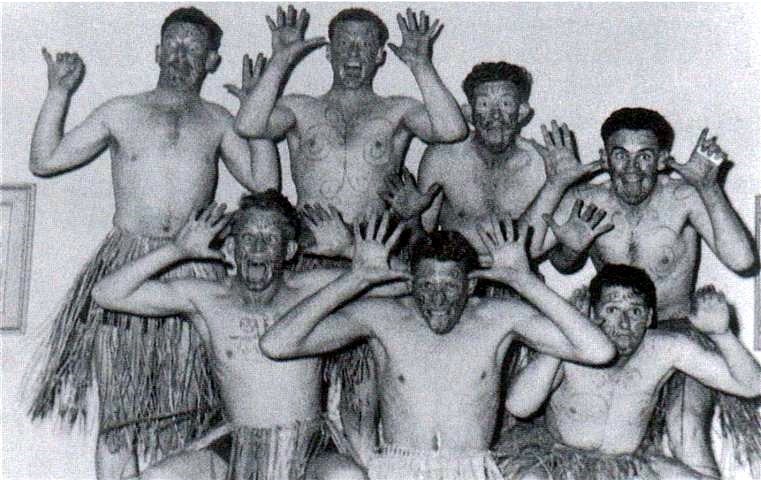
New Zealand cadets took opportunity to put on a traditional performance at the School concert.
After they became regular attenders at Portsea there was always a strong contingent, at this period threatening to outnumber the Australian students.
New Zealanders had the least trouble in settling into the School routine; indeed after preparatory periods at their recruit training unit at Waiouru and School of Tactics, they were better prepared than most of their Australian colleagues.
They occupied a disproportionate share of the senior cadet ranks until the 1970s when rising ages and education levels in the Australian students had a levelling effect.
OCS Scrapbook 1958
New Zealand introduced a pre-OCS course at its recruit centre and School of Tactics as both pre-selection and preliminary training. A report by the OCS psychology officer suggested that their system of selection tended to lock in problems: selecting a group for the army, sending the top echelon to RMC, the next to OCS and the rest to become soldiers; a little tongue in cheek, but basically they streamed school-leavers to RMC and soldiers to OCS. While the Australian Army would have been delighted if it had to suffer no more than the New Zealand failure rate, it was of obvious concern to a small army carefully budgeting to fill its officer corps with a stream of career officers. As for the cadets, New Zealanders usually filled some of the senior cadet appointments and on average their selection, maturity and preparation saw their 498 graduates well positioned in the overall ranking in each class, though their earlier pre-eminence slipped from the 1970s as higher age and rising educational levels of Australian students came into play (17).
Fijian Cadet Bogging – 1984

One part of a cadet’s survival lay in avoiding extra drills by bogging – making sure his clothing, equipment and room all were in inspection order. Newly issued clothing, brass and weapons were notoriously difficult to bring up to a highly clean and polished condition. Until a combination of expertise and wearing-in was reached, cadets were always on the margin as to whether any or all of it would pass inspection.
It was therefore necessary to spend a good portion of the scarce free or leisure time to ensure that punishments did not further erode that by attendance at defaulters parades. E.Q. Caucau is spending some time on getting boots in order so that they can be dirtied and scuffed on field training and the whole business started again.
Photo: OCS Scrapbook 1984
From the first Federation of Malaya student in the same year as New Zealand’s entry, there was a problem of language in a fast action course. Many of the subsequent students were from the Federation Military College, later Royal Military College of Malaysia, and consequently had a reasonable military background, so in order to overcome problems in colloquial language and written expression students eventually undertook pre-course studies at a successive six week Australian Familiarisation Course at the Defence Language School Laverton and a Preparatory English Course at La Trobe University. As well as that problem the pace of the course was unusual to their experience, however their 91 graduates usually put in a creditable performance, many holding cadet NCO rank in competition with their local colleagues. Singapore sent its first student a year later than the first two countries, and after a gap of five years a regular flow totalling 40 passed out to commissions in their armed forces, some national servicemen and some career officers. Another major participant was the Philippines which sent a steady flow of cadets from 1960, graduating 38; Fiji became a regular contributor from 1971 with 24 graduates, and Brunei from 1965 achieved 16. In addition there were small numbers of students from Thailand, Nigeria, Kenya, Tonga, Cambodia, Uganda and South Vietnam. For those countries where there was a linguistic and cultural gap to be bridged, their candidates attended the two preliminary courses mentioned in relation to the Malaysian cadets (18).
Brunei Cadets with Their Future Commander – 5 May 1970
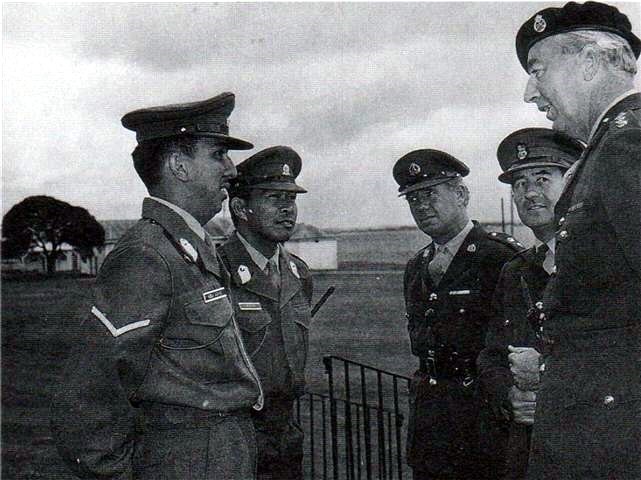
Commander of the Royal Brunei Malay Regiment, seconded British officer Col J.J. Simpson, accompanied by commandant Col J.S. McDonagh and chief instructor Lt Col J.W. Sullivan, takes the opportunity to talk to his cadets at Portsea: OICs Abdul Aziz bin Abdullah and Karim bin Sapar.
Brunei sent a regular trickle of students to the School in the early 1970s, and after a break, resumed attendance in the closing years. A total of 16 received commissions in the Royal Brunei Armed Forces where many later held command rank, replacing seconded officers.
OCS Scrapbook 1970
Papua New Guinea students first attended in 1963 as part of the planned move to self government and consequently establishment of a PNG defence force out of the Pacific Islands Regiment, an Australian Army unit with Australian officers, successor to the Papuan and New Guinea Infantry Battalions raised to fight the Japanese in World War 2. With the decision for a rapid emergence from a paternalistic Australian administration in which higher education was sparse, there were language and cultural problems to be overcome to ensure that their students could cope with the pace and extent of the training. A pre-OCS course was run at PNG Training Depot, Goldie River Barracks over 46 weeks to bring education up to SGCE, to undertake basic military training and then increase military knowledge, to increase self reliance and initiative, and to widen cultural and social horizons. Six years later after the opening of a separate school at Lae this was split into basic recruit and infantry training for 22 weeks at Goldie River followed by a similar minimum period of academic and military training at PNG Military Cadet School, based on candidates holding PNG Form VI standard (19).
PNG Military Cadet School Graduation
There is no sound on this video of graduation at the PNG Military Cadet School Graduation in 1972. Copy from the Australian War Memorial.
Ten cadets graduated recently from the Military Cadet School at Lae, Papua New Guinea. The cadets have completed an eighteen months course at the school to prepare them for entry into the Officer Cadet School, at Portsea, Vic. The parade was reviewed by the Commander of the Joint Force in Papua New Guinea, Brigadier J. W. Norrie. It was his first ceremonial parade since taking over as Joint Force Commander. After graduating at Officer Cadet School, they will return to Papua New Guinea as second lieutenants. Brigadier Norrie told the cadets that at Portsea they would have to continue to work hard, if they were to succeed. They would be in a strange environment and the pressure would be on them. They would have to work hard to do justice to themselves, their country and those who trained them. Brigadier Norrie presented prizes for public speaking, civil and military subjects to some of the cadets.
Commandants welcomed the attendance of overseas students who were prepared to pull their weight, accepting the obligation to assist developing countries in training and also recognising the benefits of exposure of Australian cadets to their peers in neighbouring countries and the mutual goodwill often engendered (20). All were adamant that there should be no alteration to the course content or standards to accommodate their problems, but a sympathetic approach was taken in guiding those in difficulties through. Another potential problem was that of dilution. This was tolerated of necessity at the turn of the 1960s when modest overseas intakes swamped Australian cadets in an era of low local applicants: civil employment had jobs aplenty and the low threat profile, lack of defence activity and poor pay and conditions of service made recruiting for the army at large extremely difficult, and headmasters reluctant to recommend a career as an army officer to their students. The majority of overseas entrants was from New Zealand and their relative standard at that stage gave some credence to Robert Muldoon’s much later aphorism that New Zealanders who came to Australia ‘raised the IQ of both countries’.
This problem subsided during the Vietnam era and need not have reappeared in the sustained inflows of the high unemployment era had not a plan been advanced for a crash programme of training 30 Papua New Guineans per year. Commandant Col J.F. McDonagh took the opportunity to discuss the whole question of a proper student balance, pointing out the already wide spectrum of academic ability from local university graduates to Pacific Islanders ‘not long out of mission school’ acknowledging that students from New Zealand, Malaysia, Singapore and the Philippines coped well enough but others had considerable difficulty. The current mix of Australian Army and RAAF cadets plus the nationalities who coped well was able to balance, absorb and foster those who had a struggle to keep up with the intensity of the course, but to impose 20 percent of each class from PNG would have required their streaming, and consequently other overseas cadets with difficulties, into separate classes. Such segregation would destroy the harmonious integration which was currently achieved and provide the opportunity for external criticism of that apparent apartheid (21).
Table 6 Overseas Student Performance 1957-73
The performance of overseas students for the years when graduation was by order of merit is in Table 6. It shows, given the initial handicap they faced, a commendable achievement against their more comfortably-placed Australian colleagues. The idea of changing the composition of the student body and its unity of operation fortunately passed, and OCS remained in Col D.M. Butler’s words ‘completely Australian in character’, dedicated to fulfilling its charter of producing officers for the Australian Regular Army, while still assisting in the production of officers for the RAAF and allied armies.
Other Students
There were other groups of non-standard Australian students besides the aviation and survey scholarships. The RAAF found it expedient to have potential ground defence officers trained at Portsea in the mid-1950s, but then decided to create its own short courses after nine had passed out of OCS, however the diseconomies of this for the few numbers required were obvious. The options of using first the Officer Cadet Wing of the School of Artillery which had been established for aviation trainees, then OTU Scheyville on its opening in 1965 were tried (22), but the realisation that properly trained ground defence officers could follow on with a full career in the administrative or equipment branches of the Air Force rather than leave when age and lack of opportunity overtook them, led to the return of RAAF candidates to OCS in 1967, where they were welcomed as known performers, one R.G. Halverson having won the sword of honour in the previous batch in 1957. A total of 30 graduated from Portsea.
Another group was much later in joining the mainstream of ARA officer training. When the WRAAC was formed in 1951 there was an immediate problem in finding sufficient trained officers to match the needs of both the Corps’ own heavy overheads for self administration, and the appointments which they were to take over to release male officers for the field force. The initial approach was to bring back wartime AWAS officers from the Reserve of Officers and give them refresher training prior to allocation to duty, in much the same way as the RMC Wings and initial Officer Qualifying courses had operated for the male officers in 1948 and 1951. This early fix also needed the same follow up which had led to the establishment of OCS: after an initial qualifying course at Mears House Watsonia in early 1952 the WRAAC Officer Cadet School was opened at Mildura for 27 week courses, later reduced to 22 weeks after the move to Georges Heights when demand predicated two courses per year (23).
By the mid-1970s sufficient thinking members of the Army had finally come to the conclusion that the maintenance of a separate corps of women soldiers, with their own hierarchy, administrative structure, uniforms, promotion and training systems was an overhead which was not only costly and divisive, but simply made no sense when female soldiers were becoming increasingly integrated into a wider range of employments throughout the Army. A strong move to remedy this brought about the disbandment of the WRAAC in 1983 to the dismay and rearguard delays of the old girls and those unable to compete on anything like equal terms, but to the delight of those who thought of themselves as equal to or better than so many of their male colleagues.
Inherent in this move had to be incorporation of the officer training system in the mainstream one. Training Command proposed amalgamation in 1975 but lack of purposefulness permitted it to be bogged down in detailed delaying tactics. In a slower approach, the entry education level to WRAAC OCS was harmonised with that of OCS in 1977, and after approval of a common standard by the Chief of the General Staff in 1979 the age range of 19.5 to 32 and the 22 week course were also altered to the Portsea standard. In October 1984 the WRAAC School Officer Training Wing at Georges Heights had its last graduation of officer cadets and with this closure 22 females entered OCS at the beginning of its final year. This was hardly a world-leading move, the New Zealand Army having opened its own fledgling officer cadet school in 1977 with a mixed male-female student body, but it at last finally sealed the end of a separate army within an army which had long passed its use by date.
Drillie and New Entrant – 1985
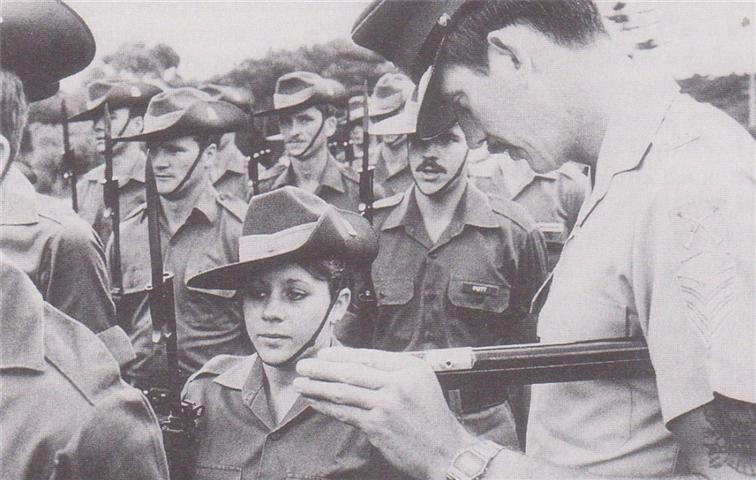
Sgt O’Donnell correcting the drill of an hitherto unusual member of the COC, OCdt N. Baker. One of the first intake of female students to Portsea, these cadets found life quite different from that of their predecessors at Georges Heights.
Although the WRAAC OCS had begun to align its syllabus with that of Portsea from 1979, it is apparent from the content of the discussions and conference to arrange the transfer that the intensity fell well short of OCS levels.
In keeping with its long-held policy in relation to overseas students, there was to be no reduction in standards on any combined course. Most of the female students met the challenge.
RMC Archives
Absorption of the female cadets was undertaken in the final year of OCS to ensure that it was a problem already solved rather than letting it impede the establishment of the new course at the Royal Military College of Australia. While there were some obvious areas of co-living and physical parity to be addressed, the planning discussions were extended in considering some eminently solvable problems by an apparent divergence of thought, on the one side an old guard rear guard attempt to keep females on a different standard, and on the other an all-soldiers-together approach. Attempts to have segregated accommodation and different physical achievement standards failed, though in practice some sensible modifications were made (24). It is interesting that, ten years on, a Defence study of training-induced longer term injury has shown a considerably higher incidence for females, putting paid to the feminist propaganda that women are intrinsically tougher than males and should be fully integrated into combat roles, a fallacy obvious to any layman not sitting behind an academic or affirmative desk. Regardless of this hindsight, the two integrated courses at Portsea successfully overcame the procedural speed bumps, the first graduating female officers rated on a par with their male colleagues with few concessions made on the physical efforts they were required to carry out as a normal part of the course, the second moving on to Duntroon to carry on the process there.
Recovering from a Run – 1985
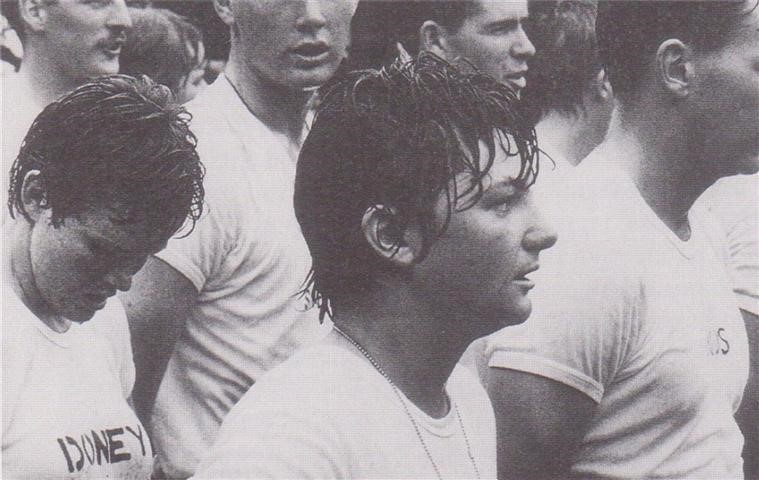
OCdts S.R.E. Doney and S.A. Miles tough it out with their male counterparts J.P. Palmer, D.M. Sweeney, E.G. McMillan and S. Amos in physical training.
Female students kept up with their male colleagues, being offered few concessions. One was minimising the equipment load in battle efficiency runs, where the stress might be excessive.
Feminist theoreticians who had been pushing stridently the toughness and physical equality of women had of course never humped a full infantry load and weapons day after day in adverse weather, without sleep, digging weapon pits, patrolling, wiring and sentry duty.
The two female components of the 1985 OCS courses were thrown in at the deep end. They were there because they accepted the challenge. Those who misjudged their capacity on the basis of the feminist propaganda left, the others stayed with it to graduate or move on to Duntroon.
RMC Archives
Retention and Separation
In the maelstrom of resignations from the Defence Force in the 1970s a politicised bureaucracy invented euphemisms which avoided recognition of the crippling losses of officers who departed realising that the old concept of the services looking after their members was false, with public servants frustrating pay increases and attempting to tamper with the superannuation scheme. Official statistics recorded retention rates rather than losses, and the term separations described the process of members leaving an employer who was perceived to be exploiting the non-industrial approach of the profession of arms. Retention had a different connotation at OCS, where commandants and instructional staff strove to guide students through the course without compromising standards, the results being reported and discussed openly and objectively in the plain language of wastage rate.
Termination of an officer cadet came from either side, students realising that either the demands of the course were beyond them or that service life was not to their liking, or the School deciding that they were not capable of reaching the necessary standard or that illness or injury precluded completion of the course within a reasonable span. Under the philosophy of regular army soldiers attending a course, at first no advice on progress was given to parents, even though students under 21 had to have the consent of parent or guardian to enter the School. This was changed in the mid-1960s to advising parents of minors if a student was having difficulty in studies, both to allow them to exert some family pressure on the student and to avoid strong reactions from them in the event of an unheralded removal or failure. Because of the sensitivity of this issue, and particularly that of overseas students, the Adjutant General and his successor the Chief of Personnel-Army reserved the final decision to remove a cadet (25), but with minor exceptions followed the recommendation of the commandant.
While recognising that maintenance of standards meant that some losses were inevitable, commandants remained concerned at any failure rate and strove to keep it to a minimum. One technique adopted was to allow repeat of part of the course to make good lost or unabsorbed instruction. From the extended course of 1955 commandants allowed repeats to retain those who had missed training, confirmed in 1957 by amendment to the Military Board Instruction allowing one repeat of either the junior of senior term, whichever was the problem, for loss of time through injury or illness, or not having made sufficient progress, provided their prospects of graduation were good: students offered a repeat were given this as an option and were not held to their engagement if they demurred. Although this limit of one term was continued through into the Manual of Personnel Administration in the 1970s, there were exceptions where it was to the mutual benefit of both parties (26).
The urge to give every deserving cadet in trouble all opportunity to make good produced many hard luck stories, some with happier endings. Commandants were aware enough of the halo effect of a cadet making a mark and then having his subsequent activities viewed in that favourable light, and conversely the bad dog image. As much as they might try to minimise this, the instructors they had to rely on were fallible human beings, and such prejudices as their gut feelings on who would make a good officer, an affinity for a cadet of their nationality or destined for their corps, the observance of an incident which coloured later views, or simple personal dislike, plus the transference of these conceptions from one assessor to another and greater or lesser dealings with different cadets all militated against absolute objectivity, as much as they were enjoined to observe it (27). Many cadets who left or repeated would have done so under the bitter conviction that they had not had a fair go, others who stayed would similarly have retained a conviction that their stay and results were adversely affected by prejudiced staff, and even by their fellow cadets. No system is perfect and that of OCS, while striving for something close, had its share of fallibility; but the final measure was the success or otherwise of the product. That this was generally up to the expectations of the army is well enough recognised, allowing that there will always be those who do not go on to capitalise on the standard which they achieved under the pressure of a training environment. That some of the casualties along the way might have been avoidable was a source of regret but likewise a product of fallibility.
Graduation in a Wheelchair – 8 June 1962
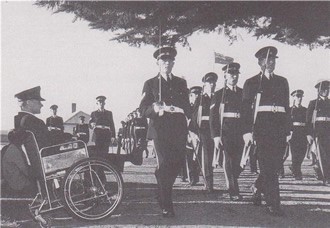
At the conclusion of the parade, the graduating class marched through the ranks of the junior class remaining in open order at the present arms, then off the parade ground to the strains of Auld Lang Syne and latterly the Maori Farewell.
To prove that all things are possible F.D.L. Greenway was able to sit out graduation parade in a wheelchair, having satisfactorily completed the course but being unable to participate by way of honourable injuries, all to the front.
This is probably the only such incident, though such claims to uniqueness often draw better stories. One thing is certain: hard luck stories outnumber good fortune by a good margin.
Photo: F.D.L. Greenway
Of the 136 cadets who repeated, the majority won through, many very creditably having overcome injury, matured or reapplied themselves to good effect. Some had unusual reprieves: R.H. Bensley was not allowed to graduate in December 1967 due to medical restrictions, but made a recovery, was commissioned in February 1968 and added to his class in the Officers List; F.D.L. Greenway was similarly positioned in December 1962 but was sufficiently on the way to recovery to both graduate and take his commission with his class; and W.S. Jolly 1980-82 had the determination and stamina to survive his way through a two year course after a bad knee injury. Similarly those under warning and repeating terms had to make a determined effort to overcome their learning or attitude difficulties to make the grade, or become part of the wastage statistics. A different extension was allowed to some overseas students quite unable to pass sufficient subjects, in recognising their governments’ desire for them not to removed at a late stage in the course, they were permitted to complete the course and issued with a certificate of attendance but not graduation.
W.S. Jolly Working on a Two Year Stint – 1980
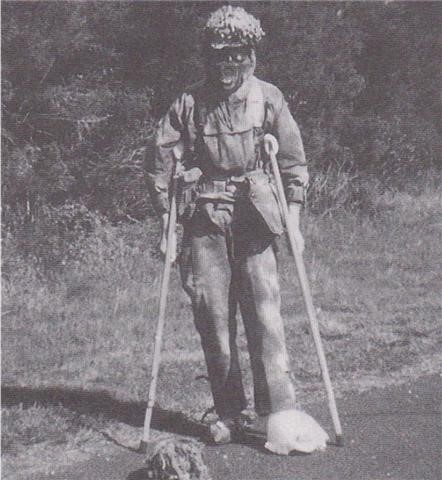
Nuclear, Biological and Chemical Warfare training was testing even to the fit, so keeping up with the class on crutches was a real test of determination.
Some students had the will to overcome adversity, some suffered injuries which prevented further participation, while others had simply had enough.
Jolly faced a similar problem to Greenway in 1980. Able to handle the course, he suffered a severe injury and having a knee reconstruction caused him to do an additional year before this test of physical and moral stamina let him graduate in 1982. The usual repeat allowed was six months, so he probably set a record also.
Photo: W:S. Jolly
Concern at the high wastage rate reached a peak in June 1972 when 41 percent of the Australian intake failed to graduate. It was accepted by Army Headquarters that it must lie in the Commandant’s discretion as to who was suitable for commissioned service, and that attempting to direct standards from afar would only result in troubles during service. One angle was that of maturity: while the 16-19 year old cadets at Duntroon had four years to grow up and develop, the one year course at Portsea had to accomplish the same in a year, with students aged 18.5 to 24 years of age. This age increment was telling at the upper end, but there was concern that some younger ones might be overwhelmed by the initial pressures of the environment after the kinder ones of home and school. A look overseas found Rowallan Company at the Royal Military Academy Sandhurst, at which immature but potentially valuable youngsters were given a pre-hardening course of 12 weeks on the outward bound model before entering the Academy mainstream. The consequent proposal to establish a parallel Blamey Company at Portsea was clutching at straws for young men of 18 upwards, where they had already been assessed for maturity during the selection board, and those considered to have merit but needing further maturity were invited to reapply in a year’s time (28). Other avenues would have to be found.
A final solution just did not exist. Wastage averaged 23 percent over the life of the School, a high price to pay but a necessary one. Confidence in the selection procedures remained high, and although these had a basic deficiency in discriminating against the non-coached and non aggressive, this excluded latent talent from entry, rather than allowing doubtfuls in. The dedication and capability of most instructors was not questioned, and consistent attempts to pre-empt failure by counselling, remedial training, holding doubtful cadets to the very end of the course, and in the last resort by repeats, all aimed to graduate as many as was safely possible. The wastage rate from 1952 to 1970 averaged 18 percent; and after the spike of 1971-72 it rarely recovered, averaging 30 percent up to 1985. While the content and level of the course continually rose, so too did the educational level of the students, though this may to some degree have been overstated in the concurrent relaxation of community secondary and tertiary standards. The sharp increase in losses at the turn of the 1970s coincided with the liberalisation programme, but much of this was later watered down and would not have been a continuing major factor. The insoluble remained unsolved, the unpalatable fact of life being that only when standards are not applied does everyone pass.
References
- AA MP927 A259/18/29 of 25 January 1951.
- AA B2453/1 R130/2/1 of 2 June, 25 June 1982.
- AA B2453/1 R284/1/1 of 19 May 1967; R130/2/1 of 27 August 1975.
- Manual of Personnel Administration para 5252; MBI166-2; AA B2453/1 R130/2/1 of 10 February 1977; AWM MSS 1479 A8411912 of 20 December 1984.
- AA MP927 A 259/18/29 of 30 May 1951.
- AA B2453/1 R723/1/2 I of E Report 1973 Annex A; MP897/127/32/9 of 8 October 1951 – a preliminary board in BCOF sent likely candidates to Sydney for interview; 9 November 1951, 15 November 1951.
- AA B2453/1 R723/1/1 of December 1958, December 1960.
- AA B2453/1 R130/2/1 of 2 June 1982, 25 June 1982.
- AA B2453/1 R723/1/1 of 7 August 1973.
- AA B2453/1 R723/1/1 of December 1953, June 1959, June 1960, December 1960, Dxember 1965 on; August 1973 Annex D.
- 82453/1 R130/2/2 of 8 February 1971.
- RMC and OCS Conditions of Service and Entry 1965 and 1966, p6f; Manual of Personnel Administration Chapter 52.
- AA MP897/127/32/9 of 8 October 1951; OCS Conditions of Entry brochure; Interviews P.P. Smith; 27/32/9 of 8 February 1952.
- AA B2453 1 I R723/1/3 of 31 August 1971; R130/2/2 of 8 February.
- AA B245311 R545/1/18 of August 1984; Manual of Personnel Administration Chapter 51; AA B2453/1R130/3/3 of 30 September 1976; R133/1/16 of 25 July 1973; RMC Archives Commandants’ Graduation Addresses 13 December 1956; see also Note 15 to Chapter 5.
- Coulthard-Clark Duntroon, p213; AA B2453/1 R133/7/9 RAAF GD Officers Policy.
- AA MP927 A259/18/29 of 28 February 1950; AA B2453/1 R133/7/1; R130/3/3 of 30 September 1976; Table 6.
- Table 7; AA B2453/1 R130/3/2 of 11 August 1983.
- AA B245311 R133f712 of January 1967; RI3317/17 of 12 March 1973.
- AA B2453/1 R723/1/1 OCS Reports 1957-65; R133/7/12 of 29 March 1971.
- AA B245311 R13317/12 of 29 March 1971; R182/1/12 of 25 July
- AA B2453/1 R133/7/9 RAAF GD Officers Policy.
- Ollif Colonel Best and Her Soldiers, p63, 106f.
- AA B2453/1 R852113/2 of 13 January, 28 February 1972; R579/1/28 Minutes of Conference of 8 March 1984; AWM MSS 1479 A84-11912 of 20 December 1984.
- B2453/1 R133/1/4 passim – until minority changed to 18.
- AA B245311 RI33/1/5 of 28 May 1957; Manual of Personnel Administration Chapter 52 Annex B.
- OCS Standing Orders Annex C to Chapter 8.
- AA B2453/1 R723/1/3 of 12 February 1975; R441/1/1 of 16 October 1983; R130/2/1 Shortfall of Graduates from OCS Annex D.